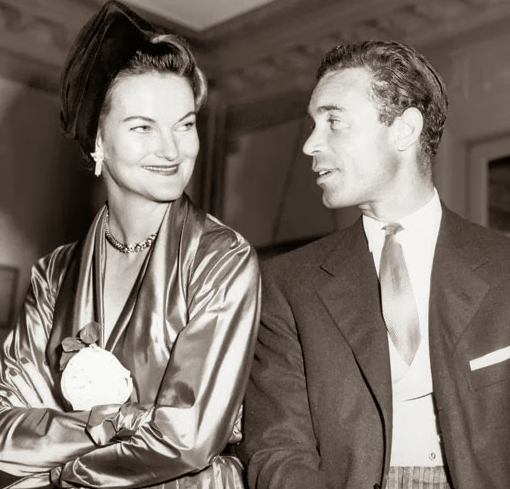A young Doris Duke with her father, tobacco tycoon James Buchanan Duke, called 'the richest little girl in the world' in 1912, which literally came true after her father’s untimely death thirteen years later
Doris Duke as young debutante, having inherited nearly all of her father’s fortune valued at more than $100 million, well over a billion in today’s dollars
Doris Duke and first husband James Cromwell, as they arrived in Honolulu in 1935,
the final stop on their 3-month honeymoon, but the marriage was over by 1940
Duke with her second husband, playboy lothario Porfirio Rubirosa,
a notorious seducer of heiresses and screen sirens — the marriage lasted a year!
For nearly 60 years, Doris Duke continued to commission and collect artifacts for Shangri La, ultimately forming an impressive collection of more than 3,500 objects and treasures from Iran, Morocco, Turkey, Syria, Span, Egypt and India, until her death in 1993. Massive painted ceilings, elaborately carved doorways, intricate mosaic tile panels, colourful textiles and ceramics, and numerous other art forms decorate the interiors of Shangri La and create an environment rich in texture and pattern. In the same way that her father transformed Duke Farms from flat New Jersey farmland into his ideal of a magnificently landscaped country estate, Doris Duke transformed five acres of Hawaii into her own private Shangri La, a place for creative self-expression and a haven from the unwanted publicity that came with being one of the wealthiest women in the world.
Doris Duke in 1966 on the terrace at Shangri La
Today, Shangri La serves as a center for the study and appreciation of Islamic arts and culture, offering educational programs such as residencies, lectures, performances and panel discussions among other special events. Recognized as one of Hawaii’s most architecturally significant homes, Shangri La is open to the public for small guided group tours, which we were fortunate to be a part of during our time in Hawaii. Managed by the Honolulu Academy of Arts under an arrangement with the Doris Duke Foundation for Islamic Art, visitors gather first at the Honolulu Academy of Arts, where a special exhibit, "Arts of the Islamic World," and a video about Shangri La precede the 15-minute drive to the estate. Docents lead the small tours through the main house and gardens, a one-of-a-kind cultural and historic attraction that accommodates less than 100 people a day, only four days a week. Booking ahead months before to secure a spot, we were able to tour Shangri La and experience the spectacular island oasis of Doris Duke, up close and personal.
Carved entrance door into Shangri La with a pair of Mongolian camel sculptures
Doris Duke with Sam Kahanamoku, the brother of Oahu famed athlete Duke Kahanamoku,
in 1938 at the front entrance of Shangri La
Banyan tree in the front parking area at Shangri La
The interior central Persian-themed courtyard of Shangri La with Islamic tiles and star-shaped fountain
The dining room themed on an Islamic-style tent
Entry into the Syrian Room with 'ajami' wood panelled walls and ceilings, carved stonework
and marble fountain and flooring
The living room with floor-to-ceiling windows that open by descending in an elevator,
an amazing architectural feat anytime, more so in 1935
The wind swept Mosaic lanai at Shangri La
Garden view of the living room (left) and outdoor dining terrace (right)
View up to the bedroom quarters which are currently closed to the public,
but due to be open next year
Carved stone steps lead to the water, from where Duke surfed and swam from
The custom yacht basin where Doris Duke anchored her yacht,
and currently a popular swimming destination
The Guesthouse, known as the 'Playhouse' at Shangri La, was inspired by the Chehel Sutun Palace in Isfahan, the capital of Iran from 1598 to 1722
The Mughul-styled gardens inspired by Duke's honeymoon visit to the Taj Mahal
A brick-paved allée with ornamental water feature, with niches for oil lamps called 'chinikhanas' that can be lit at night with candles to produce a magical effect























No comments:
Post a Comment